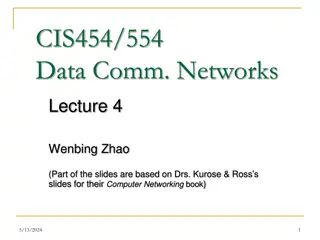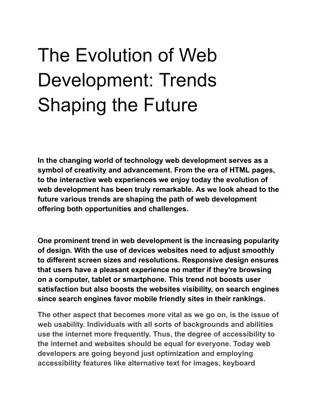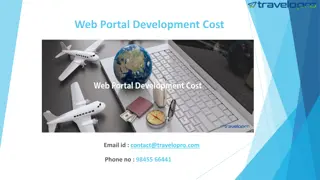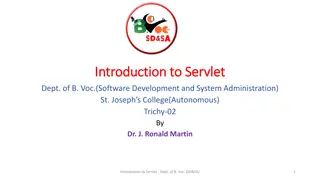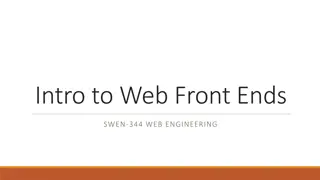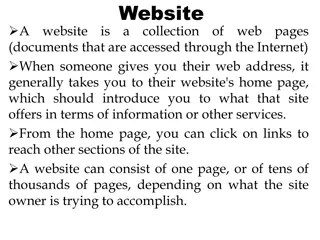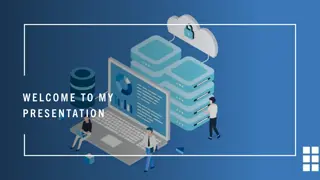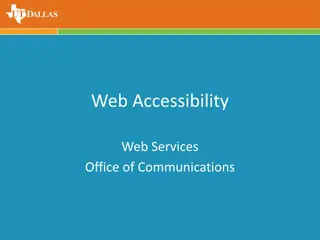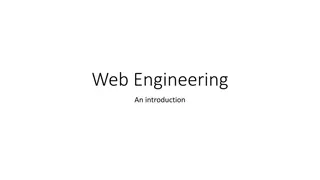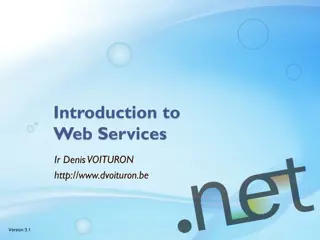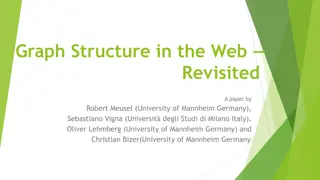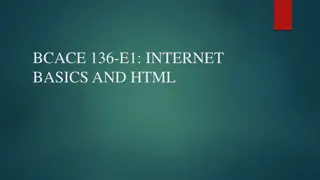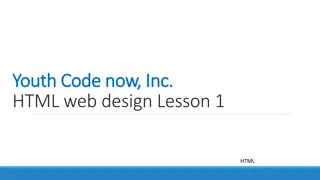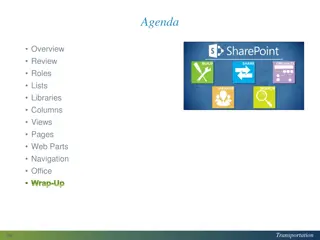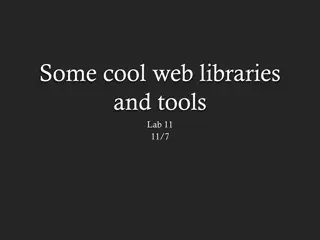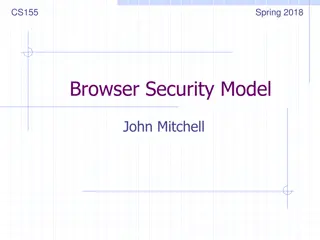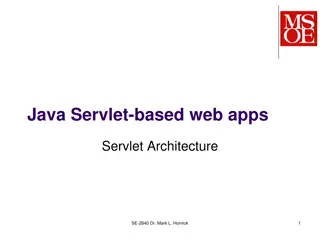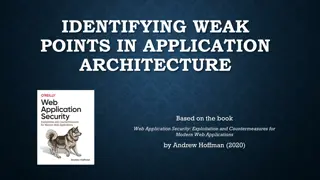Decoupled SMO Architecture Overview
Develop flows showing interaction between SMO modules in the context of open-source architecture using OSC, ONAP, and other code. The objective is to align open-source work with O-RAN trends, improve synergy, reduce duplication, and provide feedback to O-RAN discussions. Related work includes Decoup
4 views • 27 slides
Introduction to Web and HTTP Protocols in Data Communication Networks
Explore the fundamental concepts of the World Wide Web and Hypertext Transfer Protocol (HTTP) as integral parts of data communication networks. Delve into the history, structure, and key components of the web, including HTML, common tags, URLs, and HTTP. Understand how information is accessed, trans
1 views • 34 slides
The Evolution of Web Development_ Trends Shaping the Future
In the changing world of technology web development serves as a symbol of creativity and advancement. From the era of HTML pages, to the interactive web experiences we enjoy today the evolution of web development has been truly remarkable. As we look ahead to the future various trends are shaping th
4 views • 4 slides
Web Design & Development company in mohali Amrit web Web Design & Development co
Web Design & Development company in mohali Amrit web
1 views • 9 slides
Web Portal Development Cost
Travelopro offers a complete package of web portal development service and delivers feature-rich, mobile responsive solutions that seamlessly integrate with key enterprise systems. The web portal is a web-based solution that provides access to the information to a community of users, employees, supp
3 views • 14 slides
Overview of RESTful Web Services and Service-Oriented Architecture
This content provides insights into RESTful Web Services, Service-Oriented Architecture (SOA), Traditional Web Services, Overcomplication in system design, and Resource-Oriented Architecture. It discusses key concepts, technologies, and standards involved in these architectures, along with details o
2 views • 18 slides
PowerPC Architecture Overview and Evolution
PowerPC is a RISC instruction set architecture developed by IBM in collaboration with Apple and Motorola in the early 1990s. It is based on IBM's POWER architecture, offering both 32-bit and 64-bit processors popular in embedded systems. The architecture emphasizes a reduced set of pipelined instruc
2 views • 13 slides
Digital Architecture for Supporting UNICEF's High-Impact Interventions
In an ideal scenario, the digital architecture for children would encompass systems such as Enterprise Architecture, Functional Architecture, and Solution Architecture to support UNICEF's high-impact interventions. It would involve integrated platforms for Health Information Exchange, Supply Chain M
1 views • 19 slides
Understanding the Life Cycle of Servlet in Java Web Applications
Servlets are essential components in Java web development, running inside the JVM on web servers to handle dynamic web applications. This introduction covers the loading, instantiation, initialization, service handling, and destruction processes of servlets, illustrating a typical life cycle scenari
0 views • 9 slides
Understanding the Fundamentals of Web Front-End Development
Web front-ends encompass a range of key technologies such as HTML, CSS, JavaScript, and DOM, each playing a distinct role in shaping the user experience. The evolution of web standards, challenges in usability, compatibility, and accessibility, and the central role of the Document Object Model (DOM)
0 views • 14 slides
Understanding Internet Basics and Web Browsers
This content covers the basics of the Internet and World Wide Web, including the differences between the two, the functions of web browsers, components of Internet Explorer, parts of the World Wide Web, conducting effective Internet searches, understanding search results, evaluating websites, and di
0 views • 49 slides
Understanding Websites and Web Pages
Websites are collections of web pages accessed through the Internet, each with a unique web address. Users visit websites to find information they need or to complete tasks. Web pages are digital documents accessible via browsers, containing text, graphics, and multimedia elements. They serve variou
0 views • 8 slides
Understanding Web Characteristics for Building a Search Engine
Exploring the key aspects of the Web, this content delves into topics such as the size of the Web, link structure, and the number of sites present. It discusses the importance of defining quantifiable measures when assessing the Web's scale and sheds light on issues like multi-hosted servers and vir
0 views • 27 slides
Understanding Web Hosting and Server Types
Web hosting is a service that enables individuals and organizations to make their websites accessible via the World Wide Web. It provides necessary infrastructure, storage, and connectivity to ensure websites are available to users 24/7. The web hosting process involves domain names, DNS translation
0 views • 9 slides
Understanding Web Technologies and Internet Standards
Web technologies encompass various tools and techniques used for communication between devices over the internet. It includes web browsers, programming languages, databases, protocols, multimedia elements, and data formats. The World Wide Web (WWW) plays a pivotal role in connecting networks globall
3 views • 35 slides
Understanding Web Accessibility and Its Importance
Web accessibility ensures that websites are designed to be inclusive and accessible to all users, regardless of their abilities. By removing barriers, web accessibility allows equal access to information and functionality, benefiting not only users but also businesses. Accessibility is vital in vari
0 views • 10 slides
Exploring the Fundamentals of Web Engineering
Delve into the world of web engineering with an introduction to its motivation, basic paradigms, conceptual architecture, history, protocol stack, the role of the World Wide Web Consortium (W3C), and the nature of web applications. Understand the categories of web applications and how they provide s
0 views • 51 slides
Understanding REST and RESTful Web Services
REST, which stands for Representational State Transfer, is an architectural style for designing networked applications. It revolves around the concept of resources and how to represent and manipulate them in various ways. REST emphasizes a client-server communication model and offers a simple, inter
1 views • 33 slides
Introduction to Web Services by Denis Voituron
Explore the essential aspects of web services in this comprehensive guide by Denis Voituron. Understand the significance of web services, learn to create and debug them using .NET Framework and Visual Studio. Delve into topics like distributed applications, portals, service architecture, and practic
0 views • 38 slides
Semantic Web Technologies and Knowledge Representation Overview
Semantic Web technologies such as RDF, RDFS, OWL, and SPARQL form the basis of a web of data designed for machine understanding. Knowledge representation languages play a crucial role in AI, with Semantic Web languages like OWL leading the current generation. Contrasting database and knowledge base
0 views • 50 slides
Exploring Graph Structure in the Web: A Comprehensive Analysis
Delve into a detailed analysis of the web graph, leveraging a vast dataset of 3.5 billion web pages and 128.7 billion links. The study compares various features such as degree distributions, connectivity, average distances, and connected components' structures. The research aims to enhance ranking m
0 views • 16 slides
Understanding Web Browsers and Internet Explorer
Web browsers are essential software applications that allow users to navigate the internet by interpreting HTML files, handling multimedia content, managing history, and more. Learn about the features of web browsers, their support for web standards like HTML and JavaScript, and how to open Internet
0 views • 17 slides
Network Coordinate-based Web Service Positioning Framework for Response Time Prediction
This paper presents the WSP framework, a network coordinate-based approach for predicting response times in web services. It explores the motivation behind web service composition, quality-of-service evaluation, and the challenges of QoS prediction. The WSP framework enables the selection of web ser
0 views • 30 slides
Evolution of the Web: A Journey Through Time
Explore the evolution of the web from its teenage years to modern-day advancements. Witness the transformative impact of technology on democracy, communication, and society. Reflect on the web's growth and changing landscape, from passive information to active interaction. Discover how linguists stu
0 views • 57 slides
Exploring Modern Architecture Trends: Expressionism and Bauhaus Movement
Delve into the world of modern architecture trends, focusing on Expressionist architecture in Europe during the early 20th century and the influential Bauhaus movement in Germany. Expressionist architecture emphasized emotional effects through distorted forms inspired by nature, while the Bauhaus sc
0 views • 10 slides
Understanding Silverlight for Web Hosting Companies
Silverlight is a versatile web technology that provides cross-browser and cross-platform capabilities for creating rich internet applications. It allows for XML-based graphics, animation, audio, video, and event handling, scripted with JavaScript. Integration with web servers via AJAX design pattern
0 views • 16 slides
Understanding How Websites Work with HTML
HTML is the standard markup language for creating web pages. When you surf the web, your browser makes requests to web servers, which then provide responses back to display the web pages. This process allows you to access information instantly from web servers located across the globe.
0 views • 17 slides
Resources for SharePoint Designers: Enhancing Web Content
Explore valuable resources for SharePoint designers to improve web content creation, including SharePoint Help site, SharePoint Work Zone, writing tips for the web, and guidelines for user-friendly content. Gain insights on effective web writing practices and access training environments for practic
0 views • 12 slides
Overview of Web Libraries, Tools, and Frameworks for Building Web Apps
Explore various client-side and server-side web libraries, tools, and frameworks such as Angular, Ember, Rails, Express, jQuery, d3, and more. Learn about the importance of web app frameworks, the challenges they solve, and considerations for choosing between server-side and client-side implementati
0 views • 57 slides
Understanding Client/Server Computing Architecture
Client/Server Computing architecture separates clients and servers over a network, allowing for file sharing, resource allocation, and service requests. Clients initiate services from servers, with transparent server locations and message-passing transactions. Systems with C/S architecture include f
0 views • 18 slides
Understanding Memory Hierarchy and Different Computer Architecture Styles
Delve into the concepts of memory hierarchy, cache optimizations, RISC architecture, and other architecture styles in embedded computer architecture. Learn about Accumulator and Stack architectures, their characteristics, advantages, and example code implementations. Explore the differences between
0 views • 52 slides
Basic Web Security Model for Secure Electronic Commerce
This presentation covers the basic web security model for secure electronic commerce, focusing on vulnerabilities such as XSS and SQL injection. It discusses the decline in web vulnerabilities since 2009 and explores reported web vulnerabilities. The course theme includes topics like web application
0 views • 38 slides
Understanding Web Security: Threats and Protections
Exploring the landscape of web security through discussions on historical vulnerabilities, top web threats, browser security models, and the goals of web security. Delve into the world of web programming, security threat models, and learn about the goals and importance of maintaining a secure web br
0 views • 74 slides
Understanding Web Caching, Proxies, and CDNs in Web Architecture
This comprehensive guide delves into the concepts of web caching, proxies, and CDNs, explaining their importance in web architecture. It covers topics such as caching mechanisms, browser cache management, what can be cached, and controlling caches with HTTP headers. The provided images visually illu
1 views • 42 slides
Understanding Java Servlet Architecture in Web Applications
Interaction between web clients and servers in Java servlet-based web apps, from handling HTTP requests to employing helper apps for dynamic content generation. Overview of server responses, CGI helper programs, and how servlets work within a web container like Tomcat.
0 views • 20 slides
Ultimate Guide to Own Web Now's Web Hosting Platform
Dive into Own Web Now's web hosting platform through this comprehensive startup guide, which covers the process of ordering website hosting, deployment, management, and publishing website content. Learn about the Linux/PHP and Windows ASP.NET hosting options, how to configure your hosting account, m
0 views • 7 slides
Understanding the Architecture of the World Wide Web
The World Wide Web (WWW) is a vast repository of information accessible through a distributed client-server system. Users interact with web pages hosted on servers through browsers, utilizing URLs to navigate between different sites. This system consists of clients (browsers) and servers, where clie
0 views • 44 slides
Understanding the Architecture of the World Wide Web
The World Wide Web is a distributed information system that provides access to hypertext documents and various resources. Resources can include electronic documents, images, services, and more. The key concept in the Web architecture is the notion of resources, which need to be identified, represent
0 views • 42 slides
Exploring Privacy on the Web: Understanding the Deep and Dark Web
Delve into the intricate world of internet privacy, from the surface web to the hidden realms of the deep and dark web. Discover the importance of safeguarding personal data online, the significance of the Deep Web's unindexed content, and the intricacies of the Dark Web accessible via specific soft
0 views • 25 slides
Understanding Weak Points in Web Application Architecture
Information collected during the reconnaissance process can unveil critical aspects of a web application's architecture, including technologies used, API endpoints, functionality, domains, configurations, and authentication systems. Vulnerabilities in web applications often stem from poorly designed
4 views • 13 slides

